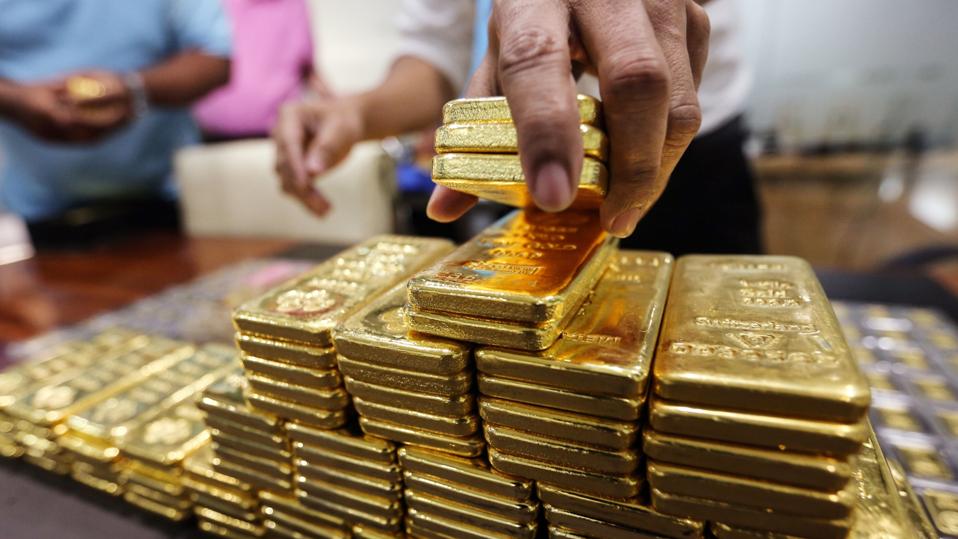Topline
Normally as mundane an investment as it gets, gold has captivated the attention of the market lately for its seemingly logic-defying, record rally in recent months, and now heads are turning toward a new, unlikely player in the gold market: Wholesale retailer Costco.
Key Facts
After topping $2,300 per troy ounce for the first time ever this month, gold prices are up a whopping 25% over the last month, a rally for the precious metal curiously overlapping with all-time highs for riskier assets like stocks and bitcoin.
Coinciding with the surge in gold prices is a viral moment for Costco’s online sales of physical gold bars—you can add to cart a roughly $2,000 bar of gold next to your toilet paper, but you have to go in person for a rotisserie chicken.
The warehouse’s gold bars typically sell out within hours as the Costco bars pose a surprisingly good vehicle for investing in gold, considering buyers can get cash back via their Costco memberships and credit cards.
“It’s time to start paying attention” to Costco’s gold sales, which could amount to over $200 million per month, Wells Fargo analysts led by Edward Kelly wrote to clients this week, noting it’s a “smart move” for the company but doesn’t expect it to materially impact Costco’s overall profitability considering the bars are sold at close to cost.
Why Are Gold Prices Skyrocketing In The First Place?
Sevens Report founder Tom Essaye explains the rally initially began late last year, as investors piled into a new refuge as the U.S. dollar lost value and interest rate expectations dwindled before getting a further bump from renewed concerns in 2024 about the potential for lingering inflation. And despite the Costco mania, it’s actually institutional investors and central banks, especially those coming from China, driving much of the surging demand for gold, as investors and bankers from China and other largely non-Western countries look to hedge against an economic downturn scenario while simultaneously lessening their dependence on the American dollar.
Crucial Quote
“The gold market is telling investors that inflation pressures could linger longer than the Federal Reserve would want,” LPL Financial’s chief economist Jeffrey Roach wrote in emailed comments Wednesday following the release of March’s consumer price index data which revealed worse-than-anticipated inflation.
Key Background
Conventional wisdom has long pegged gold as a “safe haven” asset included in portfolios to protect against stock and bond losses associated with recessions, as concerns about the economy or geopolitical instability typically cause gold prices to go up. That makes the recent rally all the more strange, as stocks are trading at record valuations and experts largely think the U.S. has avoided a full-blown recession this economic cycle. Gold prices actually fell slightly Wednesday amid a hotter-than-expected inflation report as yields for U.S. government bonds shot up and the dollar advanced, though gold is still considered a strong hedge against inflation given its long history of retaining value. The gold rally’s concurrence with strong equity and cryptocurrency returns highlights the confounding environment facing investors in recent years, as long-held truths, like stock losses accompanying a rapid rise in interest rates, have proven false, at least for now. Unlike stocks, bonds or other commodities with clearer use cases, gold derives its value from market perception of its worth, buoyed by its centuries-long history as a currency and show of wealth.
Surprising Fact
It’s been a brutal stretch for many gold miner stocks, and it’s actually for almost precisely the same reason that gold prices are up in the first place: High interest rates and soaring prices. Mining is a capital-intensive business, meaning companies disproportionately rely on debt financing, causing their bottom lines to shrivel during high-rate periods, while higher energy and labor costs are also weighing on their performance, according to Ernst & Young. The biggest U.S. gold miner, Newmont has returned -21% to investors over the last 12 months, including dividends, and Canadian behemoth Barrick Gold has returned -5%, according to FactSet data, both far underperforming the S&P’s 28% return over the stretch.
Further Reading
Costco selling as much as $200 million in gold bars monthly, Wells Fargo estimates (CNBC)

